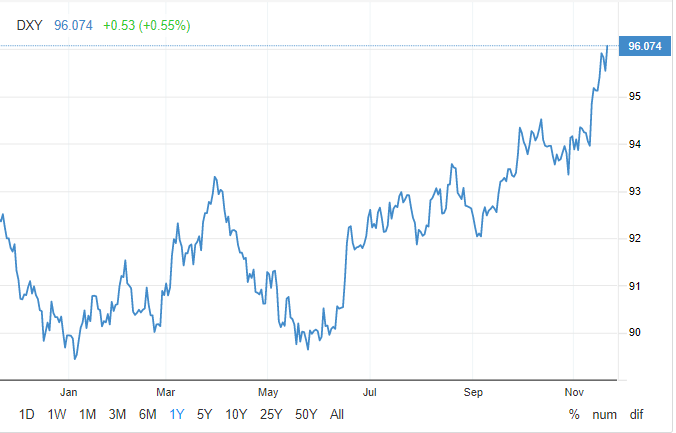Debt Could Push The Dollar Higher
The world is awash with debt. This is no secret. What is not focused upon is that most of it is denominated in USD.
Here is a situation that could really spell a lot of trouble for many entities around the world. It also could halt commodity prices in their tracks. This will also signal a reversal of the inflationary pressure that are out there.
All commodities are priced in USD. It is a situation that can have a vital impact when things get tight.
Commodities Are Capital Intensive
Capital expenditures for many commodity producers is high. They have to make enormous investments, usually years in advance, to get a payoff. Of course, with the time factor involved, it is easy to get caught investing capital as markets are dropping. This is what happened the last couple times to oil producers.
When companies carry a debt load that is priced in USD, are sensitive to moves in the USD. If that heads higher, it tends to put downward pressure on prices. This is a situation that we are starting to see.

Looking short-term, we see the rebound. If we look on a 10 year chart, we see something interesting.

The last 2020-early 2021 time period formed a double bottom. Chartists believe these are power signals for a major move higher.
Leaving the TA aside, we do know there is a lot of USD denominated debt out there. What this means is that it creates pressure, internationally, for firms to get their hands on USD. This debt cannot be paid in native currencies.
USD Shortage
What is the challenge right now we have a USD shortage globally. Due to the fiscal stimulus, a lot of USD was brought to the US as Treasuries were sold. This money was dropped into the TGA at the Fed and sent out. When the checks were deposited in the domestic banking system, the dollars were locked in there due to the easing the Fed is doing. Because of this, the banking and financial systems are awash with dollars.
The challenge is not only were dollars pulled into the domestic banking system in the US, the spread of dollars was slowed.
One of the ways they are passed around is when Americans travel. They bring their money with them, which ends up being exchanged for local currencies. When they do that overseas, the dollars end up giving the banking system what it needs.
We also see why it is imperative that the United States run a trade deficit with, well, everyone. When that happens, USD is paid to settle invoices, providing companies with the money. They, in turn, often convert it to the local currency, once again providing the banking system with the needed USD.
The slowdown in global trade is throwing a monkey wrench into this. The fact that supply chains are still messed up means that products are not flowing like they should. We see how this will disrupt the flow of USD around the world, a situation which is causing liquidity problems.
Impact On Pricing
If the Dollar rips higher, this will cause a major problem for those entities that have USD denominated debt. Anyone who is selling their product in a native currency is going to have to sell more to get the same amount of dollars. This means they are likely going to have to push prices down.
We saw this situation with China and Evergrande. It is presumed that the company was able to make the bond payment because China sold US Treasuries to raise the dollars needed to meet the obligation. With an estimated $300 billion outstanding, much of it in USD, Evergrande is going to have to sell more properties to meet the obligations if the Yuan drops in relation to the Dollar.
As we can see, this can easily turn into a spiral downward as companies that are highly leveraged in debt try to keep pace. If their currency is worth less, they end up having to sell more just to service the present debt as it comes due. This gets difficult if a country is experiencing economic contraction, or even a slowing.
This is why another slowdown in the global economy could have major effects.
It is time to start keeping an eye on the USD. All the debt that is coming due could force a major run in the currency.
If you found this article informative, please give an upvote and rehive.

gif by @doze

logo by @st8z
Posted Using LeoFinance Beta
It’s like not spending Splintershards at $0.40, but waiting for $0.80+, and leveraging with DEC while it’s high as f**k, and flowing like the waters of a mighty river, but not having a say in it because the U.S. is only accepting Splintershards so you gotta grind harder for more DEC to swap it or lose out on huge returns later.
I got this whole China thing all figured out. 😜
Well the Chinese used both USD and Yuan denominated debt so they have it on both sides.
Posted Using LeoFinance Beta
https://twitter.com/taskmaster4450/status/1461886290203484161
The rewards earned on this comment will go directly to the person sharing the post on Twitter as long as they are registered with @poshtoken. Sign up at https://hiveposh.com.
Keep up the good work
The problem is how will China and other countries get the USD to cover the debts. Do you think they will wait for the bond auctions or buy them off the open market?
Posted Using LeoFinance Beta
The ones that have it will have to sell some bonds. That is what China did. Those who do not will have to enter the forex market and swap their currency for USD.
If the native currency is dropping against the USD, that is where the problem enters. Businesses will have to generate more of their currency to get the same amount of USD to make the payments on the debt.
Posted Using LeoFinance Beta
agree cause most of the countries take debt in dollars and in that country dollar value increase and also some in hole market